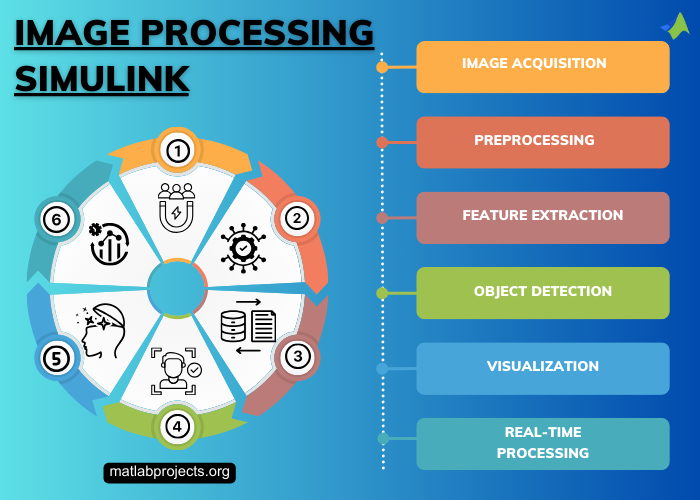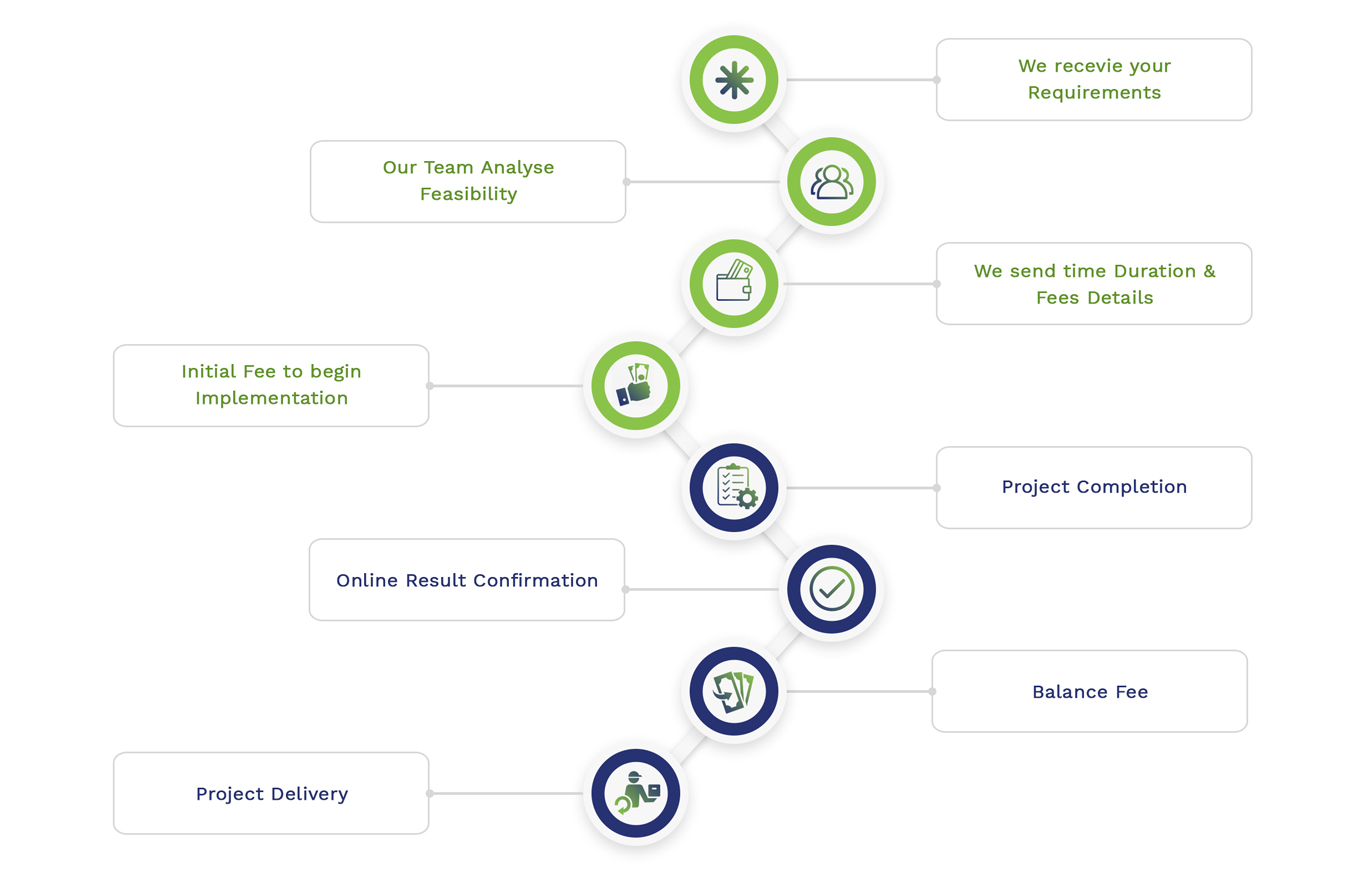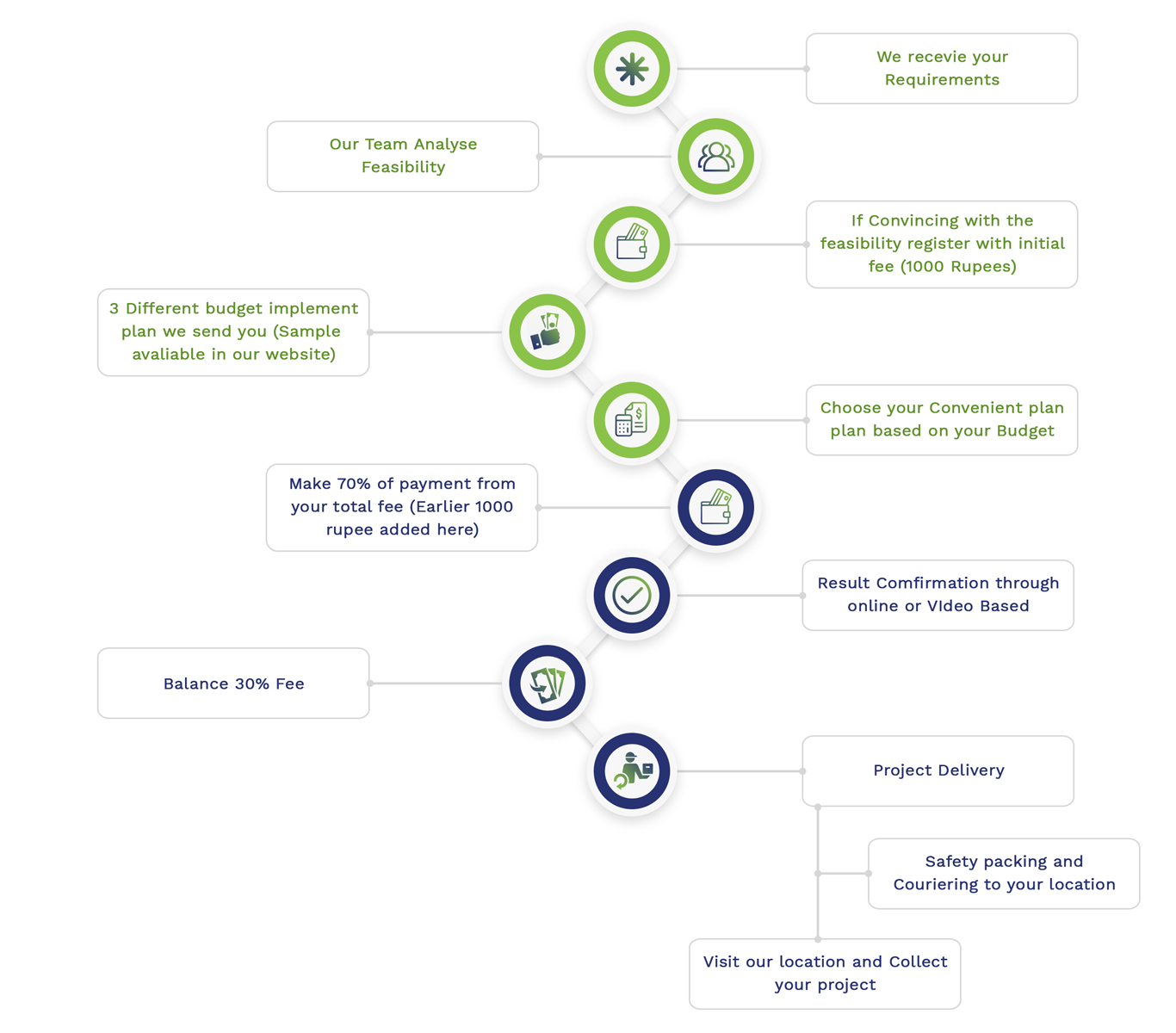The field of image processing contains various research problems, topics, technologies and potential gaps. Note the groundbreaking projects in Image Processing Simulink to enhance your technical abilities with the latest applications we’ve covered here. Stay in touch with us we share best simulation support customized to your concept. We provide an important problem statement in this domain to obtain the solution along with its approach:
Problem Statement:
To the specified processes, develop and execute an image processing system with the assistance of Simulink:
- Image Acquisition: From an image file or webcam, it is necessary to capture an input image.
- Preprocessing: To improve the standard of the input image, implement pre-processing methods like noise minimization, grayscale transformation and resizing.
- Feature Extraction: By utilizing approaches such as morphological functions, texture observation and edge detection, retrieve significant aspects from the pre-processed image.
- Object Detection: On the basis of the retrieved properties, apply methods for finding curious objects in the image.
- Visualization: With identified objects explained or showcased for visualization, present the executed image.
- Real-Time Processing: Run the images in actual-time from a live video stream by configuring the system.
Solution Procedure:
- Image Acquisition:
- To record an input image from an image file or webcam, Simulink blocks like the From Video Device block or the From Multimedia File block can be useful.
- Preprocessing:
- Particularly for image processing tasks like noise minimization, grayscale transformation and resizing, make use of Simulink blocks. E.g. for noise mitigation, grayscale transformation and resizing, apply the Median Filter block, RGB to Gray block and Image Resizer block in a corresponding manner.
- Feature Extraction:
- Through MATLAB Function blocks or Simulink blocks, apply property retrieval methods. As an example, implement the Texture Analysis block for texture recognition or the Edge Detector block for edge finding.
- Object Detection:
- For applying object identification methods, utilize MATLAB Function blocks or Simulink blocks. For instance, apply a highly difficult method using a custom MATLAB program or a basic thresholding-oriented entity finding approach through Thresholding block.
- Visualization:
- To visualize the worked image with identified entities which are emphasized or explained, employ the Image Display block. To highlight the identified things, you can connect any other explanations, labels and bounding boxes on the image.
- Real-Time Processing:
- By establishing the suitable parameters for executing blocks and image achievement, configure the Simulink framework to run images practically. To reduce latency and align with the intended frame rate, assure that the executing pipeline is improved for live-functioning.
How do I learn computer vision and image processing from basics to advanced topics like optical flow and do a medium size project in three months as an average Joe?
Computer vision and image processing are the most significant fields in this digital era which have several subareas, topics and latest technologies inside them. We offer an effective direction that assists you in learning these domains from simple to enhanced level topics:
Fundamentals of Image Processing and Computer Vision:
Materials:
- Online Courses: On computer vision and image processing basics, environments such as Udemy, edX and Coursera provide courses. It is necessary to search experimental work-outs and active projects.
- Books: “Digital Image Processing” is an extensive textbook that encloses basic theories in image processing and it is written by Richard E. Woods and Rafael C. Gonzalez.
- Tutorials: Through libraries such as scikit-image and OpenCV, research online blogs and tutorials for procedural flow descriptions of simple image processing methods.
Topics to Enclose:
- Image improvement techniques like histogram equalization, and filtering
- Image segmentation and edge identification
- Image depiction and manipulation
- Feature retrieval and representation such as corners, and key-points
- Simple object detection and recognition algorithms
Intermediate Topics in Computer Vision:
Materials:
- Latest Courses: Search courses which explore concepts as well as experimental applications. Register in courses which enclose medium topics like object analysis, matching and aspect finding.
- Research Papers: To obtain expertise into advanced methods and technologies, read essential papers in computer vision.
- OpenCV Document: For practical knowledge with applying computer vision methods, discover the OpenCV documentation and tutorials.
Topics to Enclose:
- Image registration and geometric conversions
- Object finding using techniques like Haar cascades and HOG descriptors
- Feature detection and explanation like SIFT, SURF and ORB
- Introduction to optical flow and movement estimation
Advanced Topics and Project Development:
Materials:
- Specific Courses: On modern computer vision topics such as 3D computer vision, deep learning-oriented procedures and optical flow, join webinars or learn course programs.
- Research Journals and Papers: In computer vision journals and meetings, explore in-depth within the particular topics by reading the released research papers.
- GitHub Databases: For citations and motivations, discover license-free projects and databases on GitHub that are relevant to image processing and computer vision.
Topics to Enclose:
- 3D computer vision and depth calculation
- Optical flow estimation techniques such as Lucas-Kanade, and Horn-Schunck
- Deep learning for computer vision like convolutional neural networks for object detection and image classification
- Project planning and creation: Select a normal-sized project which meets your educational goals as well as that you are passionate about. To monitor your advancement, split the project into controllable processes and establish significant stages.
Project Development and Implementation:
Procedures:
- Project Ideation: According to your passion and the topics that you have already known, design innovative project strategies.
- Project Planning: The range, needs and solutions of the project have to be stated well. For various levels of the project, design a schedule with time-limits.
- Implementation: During your educational progress, create the project by implementing the expertise and insights. For the application process, utilize libraries such as TensorFlow, scikit-image and OpenCV.
- Testing and Evaluation: To assure that your project aligns with the mentioned necessities, validate it completely. You can detect regions for further enhancement by checking its efficiency.
- Documentation: Along with the problem statement, method, application information, findings and conclusions, properly file your project. To highlight your task, develop a demonstration or document.

Image Processing Simulink Project Topics & Ideas
Discover the latest Image Processing Simulink Project Topics & Ideas for aspiring scholars looking to make a mark in their research journey. At matlabprojects.org, our team of certified experts with over 18 years of experience in Research & Development programs in Image Processing is here to assist scholars with best simulation results in crafting robust research projects.
- Quantitative wavelet domain image processing of dynamic PET data
- Image processing algorithm for extracting the phase map from structured lights
- Optimized Quantum Circuits in Quantum Image Processing Using Qiskit
- MRL-filters: a general class of nonlinear systems and their optimal design for image processing
- Characterizing Mutual Information Loss in Pyramidal Image Processing Structures
- Implementation of Virtual Instrumentation System for Estimation of Eaten Leaf Area using Digital Image Processing
- The pipeline analysis of the complex algorithms adopted in the DSP based image processing
- Hyperconnections and Hierarchical Representations for Grayscale and Multiband Image Processing
- Image processing for CT-assisted reverse engineering and part characterization
- Nonlinear wavelet image processing: variational problems, compression, and noise removal through wavelet shrinkage
- Towards scheduling hard real-time image processing tasks on a single GPU
- Improvements of Classification Accuracy of Film Defects by Using GPU-accelerated Image Processing and Machine Learning Frameworks
- Quantitative evaluation of morphological characteristics of road coarse aggregates based on image processing technology
- Partial differential equations in image analysis: continuous modeling, discrete processing
- Development of Image Processing Based on Deep Learning Algorithm
- An image processing algorithm for the in-vivo quantification and visualization of septum motion in type III B – aortic dissections with cine magnetic resonance imaging
- Level set and fast marching methods in image processing and computer vision
- Study and implement of parallel algorithms in image processing based on YH supercomputer
- Research on SAR Image Processing Performance Based on OpenMP and CUDA Parallel Model
- Fast algorithm for binary field wavelet transform for image processing
- Automatic measurement and recognition of yarn snarls by digital image and signal processing methods
- Mapping aquatic macrophytes through digital image analysis of aerial photographs: an assessment
- A semi-automated methodology for discontinuity trace detection in digital images of rock mass exposures
- Research on Fragmentation Distribution of Rock Based on Digital Image Processing Technology
- JPEG quantization step estimation and its applications to digital image forensics
- Mathematical data processing according to digital image correlation method for polymer composites
- Use of full‐field digital image correlation and infrared thermography measurements for the thermomechanical analysis of material behaviour
- A three-dimensional digital image correlation technique for strain measurements in microstructures
- Digital image correlation in experimental mechanics and image registration in computer vision: Similarities, differences and complements
- An artificial neural network approach for brain tumor detection using digital image segmentation
- Automatic recognition of atypical lymphoid cells from peripheral blood by digital image analysis
- Secure and robust digital image watermarking scheme using logistic and RSA encryption
- Effects of local rock heterogeneities on the hydromechanics of fractured rocks using a digital-image-based technique
- Use of rigid-body motion for the investigation and estimation of the measurement errors related to digital image correlation technique
- Integrated digital photography and image processing for the quantification of colouration on soiled limestone surfaces in Oxford, England
- A multigrid approach for minimizing a nonlinear functional for digital image matching
- Numerical studies on stratified rock failure based on digital image processing technique at mesoscale
- An overview of transform domain robust digital image watermarking algorithms
- Flame colour characterization in the visible and infrared spectrum using a digital camera and image processing
- Nanoscale in-plane displacement evaluation by AFM scanning and digital image correlation processing
- Separation and identification of touching kernels and dockage components in digital images
- Automated computation of leaf area index from fruit trees using improved image processing algorithms applied to canopy cover digital photograpies
- Research on distance education image correction based on digital image processing technology
- AVSynDEx: A Rapid Prototyping Process Dedicated to the Implementation of Digital Image Processing Applications on Multi-DSP and FPGA Architectures
- Computer-assisted analysis of painting brushstrokes: digital image processing for unsupervised extraction of visible features from van Gogh’s works
- Application research of digital media image processing technology based on wavelet transform
- Advanced Image Processing for Defense and Security Applications
- Embedded System for Real-Time Digital Processing of Medical Ultrasound Doppler Signals
- A SystemC-Based Design Methodology for Digital Signal Processing Systems
- Retraction Note: Research on path guidance of logistics transport vehicle based on image recognition and image processing in port area
- An SIMD Programmable Vision Chip with High-Speed Focal Plane Image Processing
- An Evaluation of Dynamic Partial Reconfiguration for Signal and Image Processing in Professional Electronics Applications
- Correction to: Percolation-Based Image Processing for the Plastic Viscosity of Cementitious Mortar with Super Absorbent Polymer
- Multiresolution Decomposition Schemes Using the Parameterized Logarithmic Image Processing Model with Application to Image Fusion
- Color in Image and Video Processing: Most Recent Trends and Future Research Directions
- Color in Image and Video Processing: Most Recent Trends and Future Research Directions
- Detection and Correction of Under-/Overexposed Optical Soundtracks by Coupling Image and Audio Signal Processing
- Neural Mechanisms of Motion Detection, Integration, and Segregation: From Biology to Artificial Image Processing Systems
- System-Platforms-Based SystemC TLM Design of Image Processing Chains for Embedded Applications
- A novel RGB Fourier transform-based color space for optical microscopic image processing
Subscribe Our Youtube Channel
You can Watch all Subjects Matlab & Simulink latest Innovative Project Results
Our services
We want to support Uncompromise Matlab service for all your Requirements Our Reseachers and Technical team keep update the technology for all subjects ,We assure We Meet out Your Needs.
Our Services
- Matlab Research Paper Help
- Matlab assignment help
- Matlab Project Help
- Matlab Homework Help
- Simulink assignment help
- Simulink Project Help
- Simulink Homework Help
- Matlab Research Paper Help
- NS3 Research Paper Help
- Omnet++ Research Paper Help
Our Benefits
- Customised Matlab Assignments
- Global Assignment Knowledge
- Best Assignment Writers
- Certified Matlab Trainers
- Experienced Matlab Developers
- Over 400k+ Satisfied Students
- Ontime support
- Best Price Guarantee
- Plagiarism Free Work
- Correct Citations
Expert Matlab services just 1-click

Delivery Materials
Unlimited support we offer you
For better understanding purpose we provide following Materials for all Kind of Research & Assignment & Homework service.
 Programs
Programs Designs
Designs Simulations
Simulations Results
Results Graphs
Graphs Result snapshot
Result snapshot Video Tutorial
Video Tutorial Instructions Profile
Instructions Profile  Sofware Install Guide
Sofware Install Guide Execution Guidance
Execution Guidance  Explanations
Explanations Implement Plan
Implement Plan
Matlab Projects
Matlab projects innovators has laid our steps in all dimension related to math works.Our concern support matlab projects for more than 10 years.Many Research scholars are benefited by our matlab projects service.We are trusted institution who supplies matlab projects for many universities and colleges.
Reasons to choose Matlab Projects .org???
Our Service are widely utilized by Research centers.More than 5000+ Projects & Thesis has been provided by us to Students & Research Scholars. All current mathworks software versions are being updated by us.
Our concern has provided the required solution for all the above mention technical problems required by clients with best Customer Support.
- Novel Idea
- Ontime Delivery
- Best Prices
- Unique Work
Simulation Projects Workflow

Embedded Projects Workflow



 Matlab
Matlab Simulink
Simulink NS3
NS3 OMNET++
OMNET++ COOJA
COOJA CONTIKI OS
CONTIKI OS NS2
NS2






